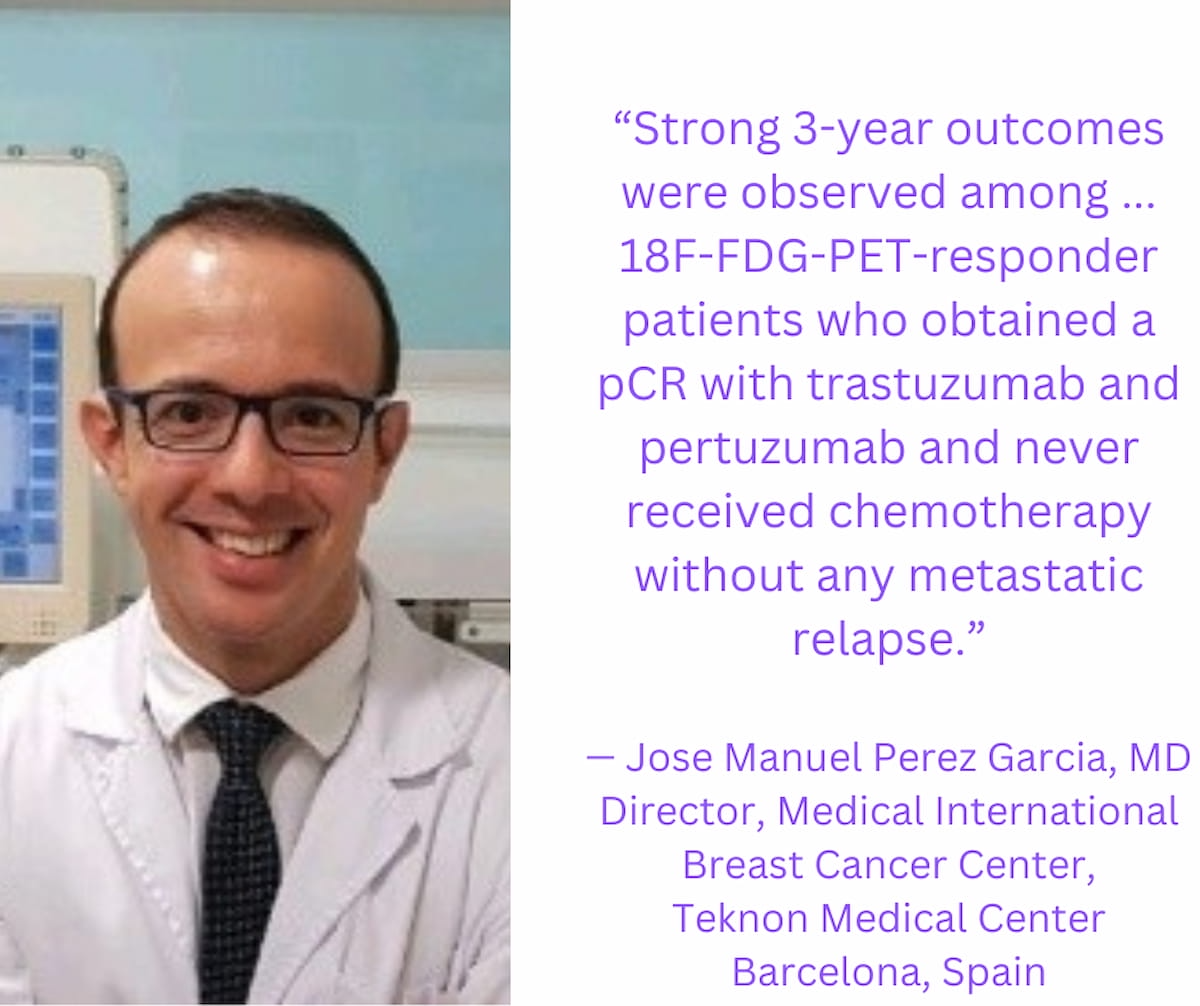The use of positron emission tomography (PET) to facilitate pathologic complete response (pCR) monitoring of a dual human epidermal growth factor receptor 2 (HER2) blockade led to a nearly 95 percent invasive disease-free survival (iDFS) rate at three years for women with early breast cancer, including patients who received no chemotherapy during the duration of the study.
For the randomized phase 2 study (PHERGain), recently published in the Lancet, researchers reviewed data from 356 patients who had HER-2 positive invasive breast cancer. All patients had operable breast cancer, ranging between stage I to stage IIIA, according to the study.
The first treatment group was comprised of 71 patients who were treated with a combination of intravenous (IV) docetaxel, IV carboplatin, subcutaneous trastuzumab and IV pertuzumab (TCHP). The study authors said the second treatment cohort of 285 patients received trastuzumab and pertuzumab with or without endocrine therapy every three weeks. The researchers noted that PET non-responders after two treatment cycles in the second cohort were switched to the TCHP group.
For the patients who received trastuzumab and pertuzumab with or without endocrine therapy, the researchers noted a 94.8 percent iDFS rate at three years. The researchers added that lymph node status, hormone receptor status and HER2 protein expression had no effect on the 3-year iDFS rate.
For the 86 patients in the second treatment group who achieved a pCR and did not get chemotherapy treatment during the study, the study authors pointed out a 96.4 percent iDFS rate at three years. The researchers noted two cases of ovarian cancer, one locoregional ipsilateral recurrence and no distal recurrence in this population.
“The PHERGain study explores an individualized 18F-FDG-PET-based, pCR-adapted strategy that allows patients who are sensitive to exclusive neoadjuvant treatment with trastuzumab and pertuzumab to omit chemotherapy. … Strong 3-year outcomes were observed among … 18F-FDG-PET-responder patients who obtained a pCR with trastuzumab and pertuzumab and never received chemotherapy without any metastatic relapse,” wrote lead study author Jose Manuel Perez Garcia, M.D., the director of the Medical International Breast Cancer Center (IBCC) at the Teknon Medical Center in Barcelona, Spain, and colleagues.
The study authors also pointed out that the first treatment group had a 29 percent higher incidence of treatment-related grade 3-4 toxicities and serious adverse events (62 percent) in comparison to the second treatment group (33 percent) and those PET-responder patients who achieved a pCR (1 percent).
Three Key Takeaways
- PET-guided monitoring enhances treatment response evaluation. The use of positron emission tomography (PET) for monitoring pathologic complete response (pCR) in HER2-positive early breast cancer patients may allow for personalized treatment strategies. PET responders who achieved pCR with trastuzumab and pertuzumab (with or without endocrine therapy, exhibited a strong 3-year invasive disease-free survival (iDFS) rate of nearly 95%.
- Chemotherapy de-escalation in selected patients: PET-guided treatment approach enabled the omission of chemotherapy in select patients who responded well to trastuzumab and pertuzumab. Patients achieving pCR without chemotherapy demonstrated an iDFS rate of 96.4% at three years, suggesting the potential for treatment de-escalation in certain cases.
- Consideration for alternative imaging modalities. Access issues and the cost associated with 18F-FDG-PET warrant exploration of alternative imaging modalities such as breast MRI or ultrasound for monitoring treatment response, especially in settings lacking PET infrastructure. Further research is needed to evaluate the feasibility and efficacy of these alternatives in guiding treatment decisions for early breast cancer patients.
While the researchers emphasize caution about the possibility of de-escalation treatments in a curative setting, they suggested that the results of this study and prior research examining the use of adjunctive paclitaxel and trastuzumab warrant consideration for patients with early breast cancer.
“The inclusion of patients with clinical stage I cancer is of special interest, considering that the current standard of care for this patient population is the combination of chemotherapy with trastuzumab,” noted Perez Garcia and colleagues.
Given potential access issues with 18F-FDG-PET, the researchers called for further research to assess the possibility of employing conventional imaging modalities to assist with pCR monitoring in this patient population.
“It would be valuable to explore the use of breast MRI or ultrasound instead of 18F-FDG-PET as an alternative assessment method of early treatment response in (centers) without access to 18F-FDG-PET,” added Perez Garcia and colleagues.
(Editor’s note: For related content, see “Positron Emission Tomography and De-Escalation of Breast Cancer Treatment: What Emerging Research Reveals,” “Assessing the Potential of Positron Emission Mammography: an Interview with Vivianne Freitas, MD” and “Current Perspectives on PET/CT Imaging in Patients with Metastatic Breast Cancer.”)
In regard to study limitations, the authors acknowledged a limited cohort size and a short follow-up period. They conceded that there is limited access to 18F-FDG-PET and said the expensive imaging modality has a learning curve. The researchers also noted that trastuzumab emtansine, an adjunctive treatment utilized for patients who are resistant to trastuzumab and pertuzumab, was not available prior to the study.

